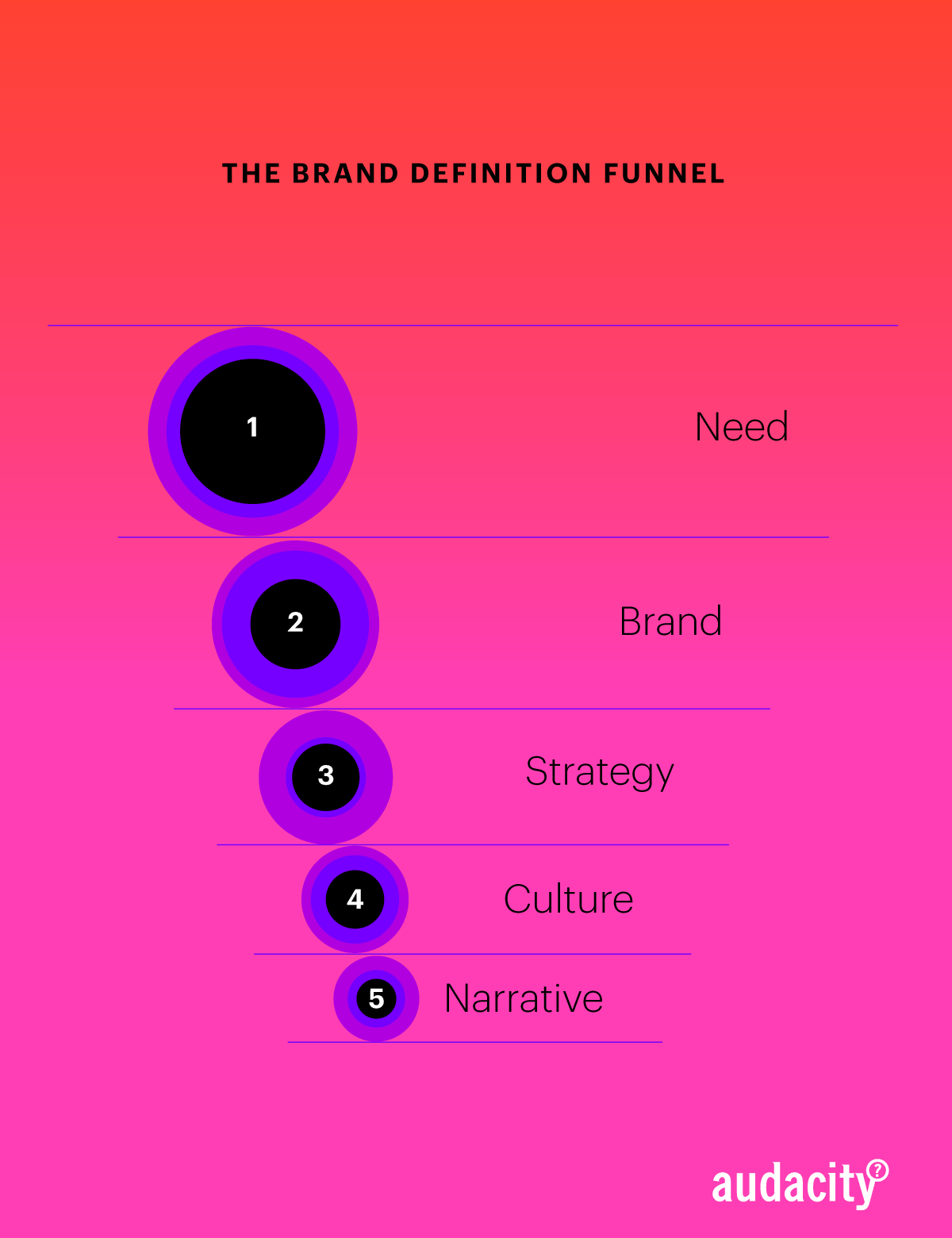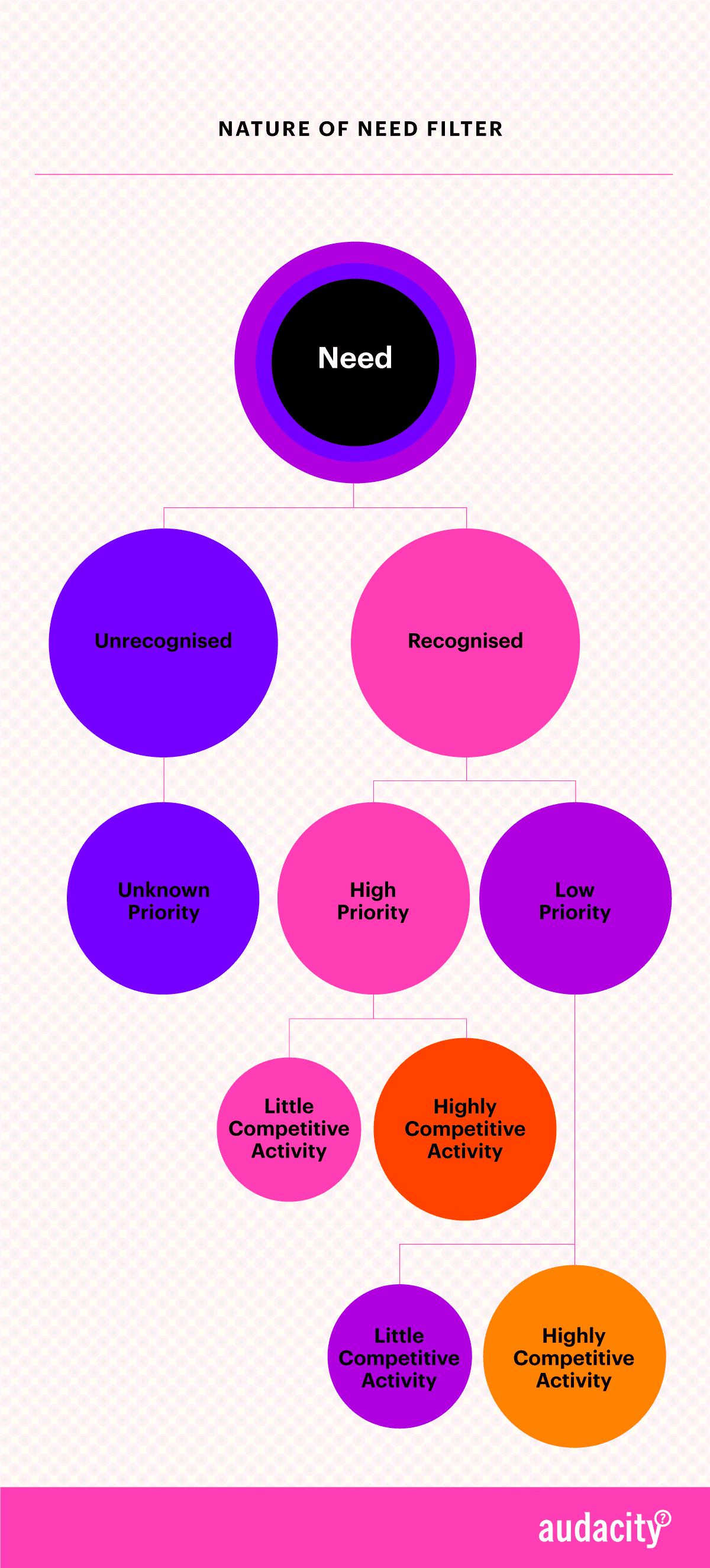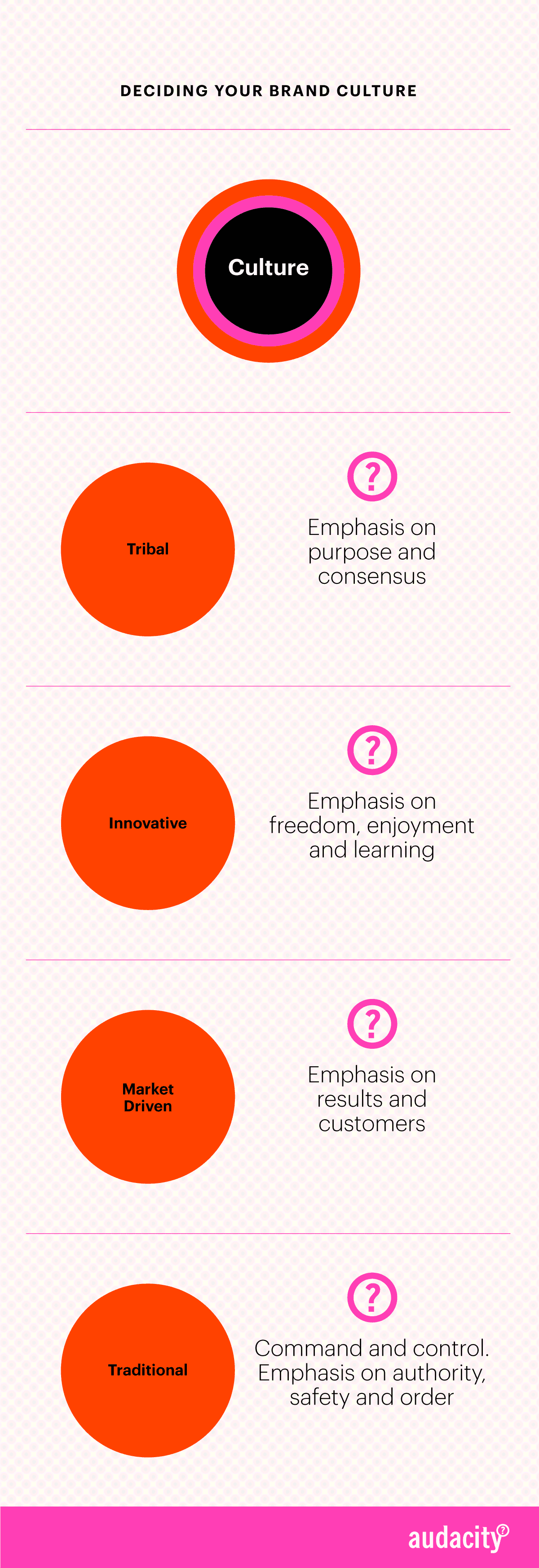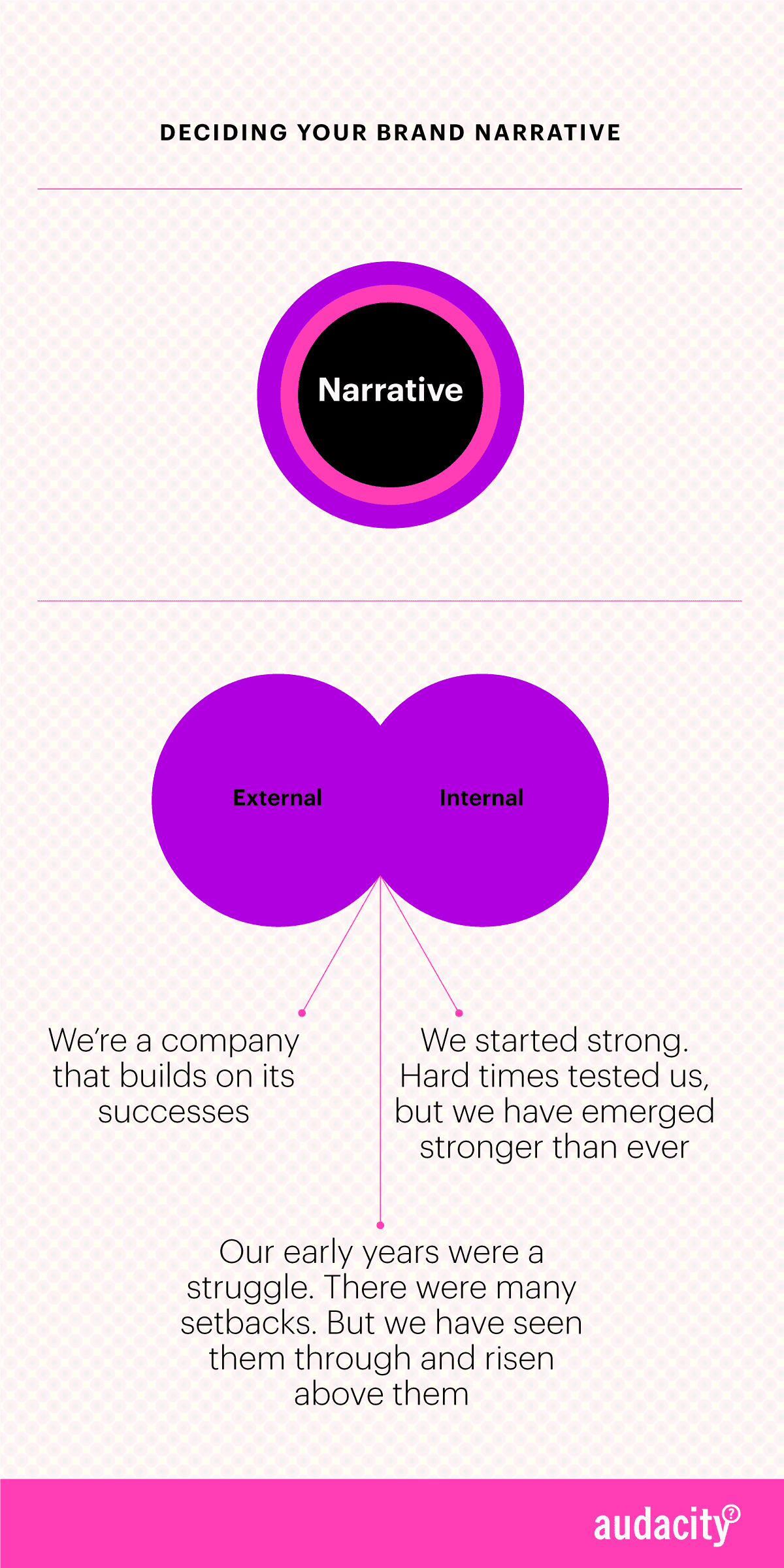We’re all aware of the consumer decision journey that describes how buyers come to decisions. But if you’re a marketer building a brand from scratch, or you are charged with reviewing what a current brand’s future looks like, how do you review all the options you need to consider in order to make critical decisions about your brand’s identity? We use the Brand Definition Funnel.
It’s easy for nay-sayers to be dismissive of the role brands today. We’ve all heard the post-brand/no-brand arguments. But brands are powerful and effective because they do a range of simple things that commodities and unbranded goods and services can’t. The most important of these probably seems like the most obvious. A brand gives a product or service an identity, and establishes its best place in the market. In so doing, it gives people something to look for and ask for.
Brands give people something to side with
Powerful brands drive selection on the basis of what people identify with. That motivates buyers to break off into branded tribes that celebrate what the brand means to them. Ford vs Holden. Manchester City vs Man United. Apple vs Microsoft. Coke vs Pepsi. British Airways vs Singapore Airlines.
The meaning of each of these brands doesn’t lie in what they offer. It’s not about travel, entertainment, technology or beverages. It’s about what they have come to represent, relative to each other.
Creating that identity so that it speaks innately to what buyers believe they’re looking for feels like it should be simple enough. But, like all things simple, the critical decisions stem from filtering complex and wide-ranging options into a consistent and succinct framework. You can do this in a range of ways. We use a variation of the sales funnel to help marketers narrow the options to a specific configuration. You can then use this to layer over more detailed and nuanced meaning and creative expression.
We call it the Brand Definition Funnel.
This Brand Definition Funnel starts with the widest consideration factor first (what’s driving demand). It then filters through the sort of brand needed, the type of strategy, the nature of the culture, and the style of narrative.
The Brand Definition Funnel

Step 1. Establishing need: What are customers looking for?
The most important decision driver for any brand is to understand what motivates customers. This is the first decision in the Brand Definition Funnel.
Do they know what they’re looking for? If they do, should you appeal to that directly or obliquely? If they don’t, is that because they don’t recognise the need yet (i.e. you are creating a need)? Or because it is a low priority?
To filter the nature of the need, we use the following decision tree:

A recognised need is one that customers know. They are looking to travel more cost-effectively. Perhaps they want to feel more energised. Or they want to be seen to succeed … Recognised needs are those straight-forward motivations that customers can easily identify. That need is then either a low priority for them or it’s much more pressing. A low priority need lacks urgency or awareness. That could be because it’s not seen as important, or because it’s taken for granted. Utilities for example supply the necessities of modern life in the form of energy and water. However, they find it much harder to build an emotive connection with customers because they are not regarded as high priority.
A high priority need is one that commands attention. Facebook, for example, talks to a recognised need for news and social interaction.
If your brand addresses a recognised need and you know how important that need is to your target market, you can then evaluate how competitive the market is.
Defining unrecognised needs
If a need is unrecognised, chances are that your offer is new. Brands that cater to unrecognised needs are looking to forge demand for something that consumers don’t yet understand. Because of this, they cannot quantify what it means to them.
If your brand is looking to meet an unrecognised need, you will need to devote a lot of your resources initially to explaining the idea. You’ll need to prove to people that there is a need for it that relates to them. At this point, simply recognising that you will need to do that is an important insight. Many people just launch an unknown brand trying to meet an unrecognised need into the market. They believe there is very little competition for them to worry about, and that people will just “get it”. Chances are, they won’t – either because they don’t understand it, or because they rule it out as unimportant to them and therefore ignore it.
Our first rule of thumb is that if a market sector appears empty, there’s probably a good reason. There are exceptions of course.
Write a needs-driven value proposition
Having established the type of need that your brand meets, the level of interest that people have in it and the amount of competitive activity focused on meeting that need at the moment, you can look to write a value proposition for the brand based on the problem that it answers for the buyer, the level of (market) education needed to make the buyer aware of the value of what is being offered, and the extent to which the brand is competing or will compete for (customer) attention.
The very powerful insight that this analysis establishes is the presence of need gaps (unmet needs) or need vacuums (no need exists or there is not enough need to establish a viable brand).
You can identify these customer needs yourself and evaluate how well you believe they are currently being met, or contact us to run a Competitive Positioning strategy session.
Step 2: Deciding your brand type.
Marketers often talk about “brand” as if it is one thing, but of course there are important sub-sets within the term that in themselves help shape what you are creating.
Brands that sit within supply chains for example are completely different from those that are customer facing. But there are also hybrids that combine a range of different characteristics at different points. Vertically integrated brands for example can be both business facing and consumer facing. They can also be “stacked” from the manufacturer to the supply chain and then through to the consumer, with different relationships and even customer bases at each level.
Equally, the architecture that the brand sits inside will determine how it does or doesn’t need to relate to other brands owned by the same company. Power brands make everything singular. In a house of brands, your brand may sit inside a portfolio that requires it to fulfil a specific role. Or your brand may be endorsed, in which case it gains strength and gives credibility to its branded owner.
Our decision tree for this step of the Brand Definition Funnel takes in 5 characteristics that will give you a much better understanding of how your brand will operate. They extend from sectoral through to structural and ultimately to style, and should be informed by the insights gathered in Step 1.

Step 3: Choosing a strategy
Knowing the nature of your customers’ needs and the broad principles governing the brand required, you can now decide which strategy you will use to best effect. As with brand, there is a tendency to use the term “strategy” as if it is one thing. In point of fact, there are different kinds of strategy available, depending on what you want your strategy to achieve.
We often explain strategy as the most powerful opportunities for your business to succeed on your terms.
Your future should be defined and controlled by you. It should be framed around how you believe you can most meet the needs of your customers. Sustainably, competitively and profitably.
Five strategic brand choices
For the Brand Definition Funnel, we have identified five key strategic choices to decide a direction for your brand that will best enable you to meet the needs of your customers.
- A scale strategy is designed to give you presence in the market. It’s suited to brands that need to “go big or go home” in their sector.
- A differentiation strategy focuses on building a brand with a distinctive point of view.
- An efficiency strategy is often associated with a value-based brand. It’s intended to make it as easy as possible for consumers to buy what you offer.
- A diversification strategy is about expanding your presence by leveraging the power of your brand. It differs from a scale strategy in that diversification is about using the recognition you already have in one market to build new opportunities in other markets.
- Finally, a focus strategy is for those brands that you previously identified as either having cult appeal or talking to a niche audience. They do a small number of things, very well.
To decide your strategy, first choose one of the strategic choices. Then use the next level of detail to decide how you will bring your strategic choice to life.

Start with one strategy. But that may change
Again, it’s possible your brand could combine aspects of these different strategies to achieve competitive hybrids. For example, a scale driven brand can use its size and presence to offer efficiencies that are not available to its smaller competitors. Equally, a brand can progress through different strategies over time. It might start out with an efficiency strategy and progress through scale, differentiation and then diversification. If you have such ambitions and you can plot these pathways, this is the time to do so. If not, start with the strategy that makes the most sense for what you know your customers need.
Step 4: Identifying your culture
Your strategy and your culture are not competitors. In fact quite the opposite. Each must complement and reinforce the other.
Many organisations think of their current culture as the given they have to work with. But getting this right is about defining the culture that will best work for you – and then drawing on powerful tools like leadership, recruitment, training, incentives, structure and policy to encourage the culture that best aligns with who you need to be and how you need to perform to realise your potential.
That’s not always easy of course. In The Leader’s Guide to Corporate Culture, the authors identify culture as the tacit social order of an organisation. There are, they say, four attributes that decide the culture you have:
- Shared – your culture is the expression of what the group believes and holds dear
- Pervasive – this weight of presence feeds how people behave, how they work, what they tell themselves and the manner in which they make decisions
- Enduring – it exists beyond the individuals involved to the point where people come and go on the basis of their ability to find their place within the culture
- Implicit – it acts as a silent language
We use a variation of the model developed by Kim Cameron and Robert Quinn to identify where a culture is now and what it will need to be in order for the strategy to succeed.
Delivering to the strategy
For example, a project we did for a large digital company identified that the culture they had was inclusive and consultative. But that culture slowed their ability to respond to market changes. In order to deliver on their strategy, the company had to shift to a culture that was more performance driven and responsive to rapid changes in customer behaviour. Knowing that, we were able to put a culture change programme in place to make that change.
The eight types of culture identified by Boris Groysberg, Jeremiah Lee, Jesse Price and J. Yo-Jud Cheng add valuable characteristics. They inform not just the relationship between these ideas, but also the environments in which ideas are most likely to coexist or generate tension. For the purposes of the Brand Definition Funnel, we’ve combined our take on Kim Cameron and Robert Quinn’s model and on the model featured in HBR. Together, they help you make decisions about the core nature of your desired culture.

Most cultures are not singular, in that they combine a range of attributes to make them work well. But in order for you to achieve your strategy, one of these cultural approaches is likely to be dominant.
Step 5: The type of narrative you will tell
Brands must look forward of course. But they must also track back. Your brand’s past is part of the story of your brand so far.
We often talk about a brand’s narrative being a combination of your history and your strategy.
Researchers from the University of Vermont’s Computational Story Lab have identified six basic story types. Each has a different shape and a different ending. Three fail. Three triumph.
Given that you expect your brand to succeed, there’s a good chance you won’t want to duplicate the tragic storylines. The other three options – rags to riches, Cinderella and In a hole – offer powerful story arcs for your brand’s narrative. Choose one of these for this part of the Brand Definition Funnel. Linking your narrative type to your strategy will enable you to map your history and project your future. That way, you have complete control over the storylines that your customers and prospects come to see.
Knowing your narrative puts you in control.
Example: A gaming company with long storylines
Several years ago, Mark visited one of the biggest gaming companies in the world. On the visit, he learned that they have storylines that stretch out 10 – 15 years. They map new product releases and upgrades against the narrative and develop them with that arc in mind. So the company is always working to “what’s next” rather than just reacting. Not every brand is going to want to build a storied universe of course, but planning how you will tell the story of how you overcame challenges and achieved moments of triumph means you can use the natural power of story to your advantage.
The decision tree for your narrative needs to align with your strategy and the brand. It must also connect with the type of culture you envisage. Each of the elements works together to rule in, and rule out, options. By the time you’ve decided your story arc, you have made the critical decisions that will inform and guide all the work that follows. That’s what makes the Brand Definition Funnel so powerful.

Once you’ve decided the story arc, you can plot where you believe you are in terms of the story’s progress. For now though, you just need to understand the type of narrative you want to tell.
Funnel all this to define the brand you are building
As a result of using this Brand Definition Funnel, you’ll know critical important things about your brand:
- How it meets the needs of customers
- The form of the brand itself
- The strategy it will pursue
- The culture it will build
- The type of narrative it will use
We suggest you capture this in a paragraph. For example:
The ___ brand we’re building meets a need that customers have identified as _____ and which, at this point, is _______. In response/To counter this, we’ll be developing a service focused, B2_ brand with a ______ based audience. The brand will be part of our portfolio of __________. We will specifically position ourselves to take on __________ as a challenger. To achieve differentiation, we’ll be adopting a strong challenger mindset, and building a culture to support the brand that is _____. Our narrative to the market will focus on how we were ______________ and are now ready to do battle with _______ directly.
A powerful definition
See how the Brand Definition Funnel lets you simply and succinctly express what you are seeking to build.
Armed with this understanding, you can now attack the detail of every aspect of your brand’s strategy and core identity. You can brief leaders on how the brand will work and the impacts it will have. And you can prepare informed and detailed briefs that lay out the parameters for plans, campaigns and concepts.
There’s still a lot of work to do of course. We would recommend you fully explore where your strategy, culture and narrative could go. But having this Brand Definition Funnel handy and referring to it regularly as you bring your brand to life will keep you on course and ensure everything you do builds on critical decisions.
How to get started
To get to grips with how your brand will meet the needs of your customers better than your competitors, book a Positioning strategy session and together let’s map how you can thrive in your market.
If your leadership team needs to better connect the dots between your strategy, culture, story, customers and how your leaders as a team lead out your brands, talk to us about a strategic session and bring them together to focus on the opportunities. Or let us run a Discovery workshop to uncover what’s working, what’s not and where powerful linking opportunities might be being missed.

